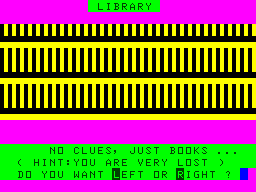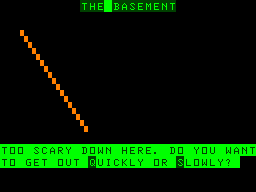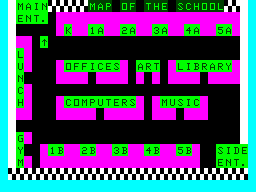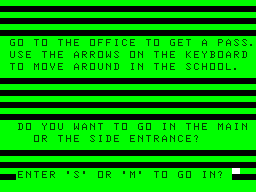Retro Replay Review
Gameplay
School Maze offers a measured, methodical approach to exploration that will appeal to fans of classic text-and-graphic adventures. Instead of fast-paced action or complex combat systems, the game challenges you to navigate the halls of a sprawling school building by issuing simple directional commands. Your primary objective is to retrieve an important computer tape, but before you can begin your quest in earnest, you must first secure a pass from the school office. This initial task sets the tone for a gameplay experience rooted in careful observation and problem-solving rather than reflex-based challenges.
Each room you enter is presented using character block “semigraphics,” and movement is handled by pressing keys that correspond to the four cardinal directions. Though this system might feel primitive by modern standards, it encourages you to form a mental map of the school’s layout. You’ll soon find that pressing “North” followed by “South” doesn’t always return you to the same spot, adding a layer of complexity and potential disorientation that keeps exploration fresh. Finding your way depends not only on memorizing room connections but also on paying attention to subtle visual cues in the block graphics.
Beyond simple navigation, School Maze peppers the building with special-function rooms that break up the monotony of corridor-hopping. In the music room, for example, you can experiment with keyboard notes to trigger hidden events or simply enjoy a brief respite. Over in the lunch room, taking a moment to eat can restore your character’s stamina, hinting at an early form of resource management. While these features are modest, they inject moments of delight into what might otherwise be a purely utilitarian adventure.
Graphics
The visuals in School Maze are as straightforward as the gameplay itself, relying on character block graphics to stand in for walls, doors, desks, and other school fixtures. There’s no detailed pixel art or full-motion animation—just the BASIC-era charm of semigraphics that evoke the environment with minimal lines and shading. For players who cut their teeth on early home computer titles, these graphics are a nostalgic treat, recalling an era when imagination filled in the gaps left by hardware limitations.
Each room has its own distinct layout, drawn in monochrome or with simple color fills, so you can quickly differentiate a classroom from the library or the cafeteria. Although the representations are rudimentary, they communicate enough information to guide your exploration and hint at possible interactions. The simplicity also means that load times are virtually nonexistent and the entire game can run on modest hardware without a hitch.
Special rooms introduce subtle visual flourishes that signal unique functions. A piano keyboard rendered in block characters, for instance, instantly tells you that this room is about music, and an icon of a plate and utensils flags the lunch room. These small touches help anchor the world and keep you oriented despite the overall minimalism. If you’re seeking eye-candy or high-definition detail, School Maze won’t satisfy—but as a piece of retro gaming history, its graphics are both charming and fit for purpose.
Story
At its heart, School Maze weaves a simple yet effective narrative: an important computer tape has gone missing somewhere in the school, and you’ve been tasked with finding it. While the plot doesn’t delve into deep character arcs or philosophical themes, it provides just enough motivation to propel you from one corridor to the next. The school setting feels familiar, and the everyday tasks—getting a pass, collecting clues, finding keys—ground the adventure in a relatable world.
The story is told almost entirely through environmental interactions and brief text prompts rather than lengthy cutscenes or dialogue trees. As you explore room after room, you’ll uncover hints that guide you toward the tape’s location: a cryptic note on the blackboard, a half-hidden ledger in the administration office, or a snippet of conversation overheard in the hallway. This minimalist approach to storytelling encourages you to pay attention to every detail, turning the search into a satisfying scavenger hunt.
Although there’s no branching narrative or multiple endings, the sense of accomplishment derived from finally locating the tape and making your way back to the office office feels earned. The straightforward storyline and lack of red herrings mean that progress is primarily a matter of patience and persistence. If you enjoy unraveling simple mysteries in a low-pressure environment, School Maze delivers a satisfying, if brief, narrative journey.
Overall Experience
Playing School Maze today is less about cutting-edge graphics or sophisticated mechanics and more about appreciating the roots of the adventure genre. It’s a game that invites you to slow down, form a mental map, and take pleasure in the gradual unveiling of its modest world. Each keypress feels deliberate, and every new room you discover reinforces the sense that you’re on a true exploratory quest rather than a linear corridor run.
However, the game’s very simplicity can also be its greatest hurdle. Without a built-in automap, it’s easy to become disoriented, and players who prefer fast-paced action or abundant hand-holding may find themselves frustrated. There’s a learning curve to understanding the blocky layouts and the directional quirks, so patience is a must. That said, overcoming these obstacles provides a genuine sense of accomplishment, especially for those who prize old-school design philosophies.
In the end, School Maze is a niche title best suited for retro enthusiasts, BASIC hobbyists, or anyone curious about the early days of home computer gaming. It won’t compete with modern adventures in terms of spectacle or complexity, but it shines as a historical artifact—a testament to what creative designers could achieve within tight technical constraints. If you’re looking for a short, cerebral journey through a semigraphical school environment, this little BASIC adventure still has plenty to offer.
 Retro Replay Retro Replay gaming reviews, news, emulation, geek stuff and more!
Retro Replay Retro Replay gaming reviews, news, emulation, geek stuff and more!









Reviews
There are no reviews yet.